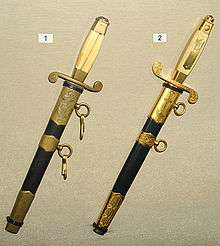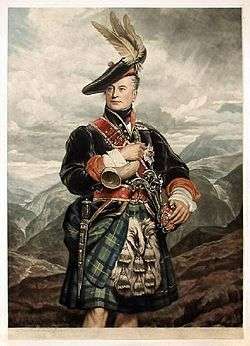Dirk
A dirk is a long thrusting dagger.[1] Historically, it was a personal weapon of officers engaged in naval hand-to-hand combat during the Age of Sail[2] as well as the personal sidearm of Highlanders. It was also used by the officers, pipers, and drummers of Scottish Highland regiments around 1800[1] and by Japanese naval officers.[3]
.jpg)
Etymology
The term is associated with Scotland in the Early Modern Era, being attested from about 1600. The term was spelled dork or dirk during the 17th century,[4] presumed related to the Danish, Dutch and Swedish dolk, and the German dolch, tolch; from a West Slavic Tillich. Dirk's exact etymology is unclear.[5][6][7][8] The modern spelling dirk is probably due to Samuel Johnson's 1755 Dictionary.[9] The term is also used for "dagger" generically, especially in the context of prehistoric daggers such as the Oxborough dirk.
Naval dirk

A thrusting weapon, the naval dirk was originally used as a boarding weapon and functional fighting dagger.[2] It was worn by midshipmen and officers during the days of sail, gradually evolving into a ceremonial weapon and badge of office.[2] In the Royal Navy, the naval dirk is still presented to junior officers; their basic design has changed little in the last 500 years.[2]
The naval dirk (Polish kordzik, Russian кортик) became part of the uniform of naval officers and civilian officials in the Navy Department of the Russian Empire and in the Soviet navy an element of the dress uniform of officers. Later, it became an element of other uniforms as well, e.g. of officers in the Russian and Polish army and air force and of the police forces in some countries.
Highland dirk

The Scottish dirk (also "Highland dirk", Scottish Gaelic: Biodag), as a symbolic traditional and ceremonial weapon of the Highland Cathairean (cateran or warrior), is worn by officers, pipers and drummers of Scottish Highland regiments. The development of the Scottish dirk as a weapon is unrelated to that of the naval dirk; it is a modern continuation of the 16th-century ballock or rondel dagger.
The traditional Scottish dirk is a probable development from the 16th century but like all medieval societies, the Highlander needed a knife for everyday use. The dirk became symbolic of a Highland man’s honour and oaths were sworn on the steel which was believed to be holy. The following highlights the importance of the dirk in Highland culture:
The dirk occupies a unique niche in Highland culture and history. Many Highland Scots were too cash-poor to buy a sword, but virtually every male carried a dirk—and carried it everywhere! If in Japan the katana was the soul of the Samurai, in Scotland the dirk was the heart of the Highlander. In many warrior cultures oaths were sworn on one's sword. Among the Gael, however, binding oaths with the force of a geas (involving dire supernatural penalties for breaking such an oath) were sworn on one's dirk. The English, (British) aware of this, used the custom against the Highlanders after Culloden: When Highland dress was prohibited in 1747 those Gael who could not read or sign an oath were required to swear a verbal oath, "in the Irish (Scots Gaelic) tongue and upon the holy iron of their dirks", not to possess any gun, sword, or pistol, or to use tartan: "... and if I do so may I be cursed in my undertakings, family and property, may I be killed in battle as a coward, and lie without burial in a strange land, far from the graves of my forefathers and kindred; may all this come across me if I break my oath."[10]
During the period of proscription, only service in a British regiment permitted Highlanders to bear their traditional arms and dress. The 78th Fraser Highlanders, raised in 1757, wore full highland dress uniform;[11] their equipment was described by Major-General James Stewart in 1780 as including a "musket and broadsword, to which many soldiers added the dirk at their own expense."[11][12]
The modern development of the Scottish dirk into a ceremonial weapon occurred during the 19th century. The shape of the grip developed from the historical more cylindrical form to a shape intended to represent the thistle. Fancier fittings, often of silver, became popular shortly after 1800. The hilts of modern Scottish dirks are often carved from dark colored wood such as bog oak or ebony. Hilts and scabbards are often lavishly decorated with silver mounts and have pommels set with cairngorm stones. The blades measure 12" in length and are single edged with decorative file work known as "jimping" on the unsharpened back edge of the blade.[13] When worn, the dirk normally hangs by a leather strap known as a "frog" from a dirk belt, which is a wide leather belt having a large, usually ornate buckle, that is worn around the waist with a kilt.[14] Many Scottish dirks carry a smaller knife and fork which fit into compartments on the front of the sheath,[15] and a smaller knife known as a sgian dubh is also worn tucked into the top of the hose when wearing a kilt.[16]
See also
References
- Chisholm, Hugh (ed.), Dagger, The Encyclopædia Britannica, 11th ed., Vol. VII, New York, NY: Cambridge University Press (1910), p. 729
- O'Brian, Patrick, Men-of-War: Life In Nelson's Navy, New York: W.W. Norton & Co., ISBN 0-393-03858-0 (1974), p. 35
- The imperial Japanese navy, Author Frederick Thomas Jane, Publisher W. Thacker & co., 1904 P.276
- Head, T.F. The Concise Oxford Dictionary of English Etymology Oxford University Press (1996) ISBN 0-19-283098-8
- Hoad, T.F. The Concise Oxford Dictionary of English Etymology Oxford University Press (1996) ISBN 0-19-283098-8
- Hensleigh Wedgwood, A dictionary of English etymology, 1859.
- Collins English Dictionary 21st Century Edition Harper Collins (2001) ISBN 0-00-472529-8
- Robinson, M. (ed.)(1985). The Concise Scots Dictionary. Chambers. ISBN 0-08-028491-4.
- Johnson, Samuel (15 April 1755). A Dictionary of the English Language: In which the Words are Deduced from Their Originals; and Illustrated in Their Different Significations by Examples from the Best Writers. To which are Prefixed, a History of the Language, and an English Grammar. 1 (1 ed.). 17 Gough Square, London: W. Strahan. 597.
DIRK. n. s. [an Earse word.] A kind of dagger used in the Highlands of Scotland. In vain thy hungry mountaineers Come forth in all their warlike geers, The shield, the pistol, the dirk, and dagger, In which they daily wont to swagger. Tickell
CS1 maint: location (link) - Seago, Dale (1999). The Weapons and Fighting Methods of the Highland Scots: A Study of the Historical Swordsmanship and Warfare Practices of the Scottish Highlanders.
- Browne James, A History of the Highlands and of the Highland Clans, Vol. IV, Edinburgh, Scotland: A. Fullarton & Co. (1838), p. 250
- Grant, James, British Battles on Land and Sea, Vol. II, London: Cassell, Petter & Galpin (1873), p. 82
- Fisher, Jay. "Custom Knife Embellishment". Retrieved 29 January 2015.
- Van Witsen, Leo, Costuming for Opera: Who Wears What and Why, Volume 2, Bloomington, IN: Indiana University Press, ISBN 0-8108-2933-9 (1994), p. 133
- Whitelaw, C.E., Scottish History & Life: Scottish Weapons, Glasgow, Scotland: James Maclehose & Sons (1902), p. 238
- MacGregor, Geddes, Scotland: An Intimate Portrait (1st ed.), Boston: Houghton Mifflin Co., ISBN 0-395-56236-8, ISBN 978-0-395-56236-9 (1980), p. 40
External links
| Wikimedia Commons has media related to Dirks. |
- Spotlight: The Scottish Dirk (myArmoury.com article)